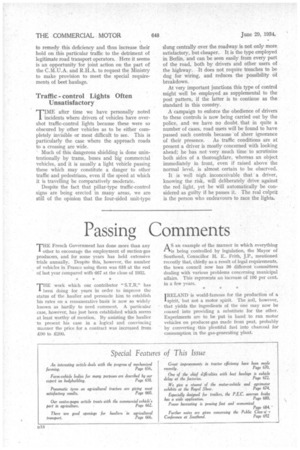Beet Haulage and the New Act
Page 71

Page 72

If you've noticed an error in this article please click here to report it so we can fix it.
IT is the practice of those haulage contractors who concern themselves with beet transport to reserve certain vehicles especially for that work. The machines are not generally new, but are old vehicles kept for the purpose—sometimes purchased specially with that end in view. They are overhauled at leisure during the summer and worked hard during the winter. Road Fund licences are taken out accordingly.
In future, of course, short-period licences will have to be taken out in accordance with the terms of the Road and Rail Traffic Act. In that connection a difficulty arises. It is impossible for farmers to estimate, within 20 per cent., the quan tity of beet which they will harvest per acre ; at least they cannot quote a figure until they actually begin to lift the crop. • On the other hand, eight weeks' notice is required from applicants for these licences.
This will place many hauliers in a difficulty. They must not over-estimate their requirements, nor does it profit them to do so. On the other hand, if the beet crop be a good one, there will be a shortage of authorized vehicles available from hauliers with whom the farmers are accustomed to deal. One result of this will be to play into the hands of the railway companies, which, with a large floating reserve of machines, will be able to remedy this deficiency and thus increase their hold on this particular traffic to the detriment of legitimate road transport operators. Here it seems is an opportunity for joint action on the part of the C.M.U.A. and R.H.A. to request the Ministry to make provision to meet the special requirements of beet haulage.
Traffic control Lights Often Unsatisfactory
'T IME after time we have personally noted 1 incidents where drivers of vehicles have overshot traffic-control lights because these were so obscured by other vehicles as to be either completely invisible or most difficult to see. This is particularly the case where the approach roads to a crossing are wide.
Much of this dangerous shielding is done tinintentionally by trams, buses and big commercial vehicles, and it is usually a light vehicle passing these which may constitute a danger to other traffic and pedestrians, even if the speed at which it is travelling be comparatively moderate.
Despite the fact that pillar-type traffic-control signs are being erected in many areas, we are still of the opinion that the four-sided unit-type slung centrally over the roadway is not only more satisfactory, but cheaper. It is the type employed in Berlin, and can be seen easily from every part of the road, both by drivers and other users of the highway. It does not require trenches to be dug for wiring, and reduces the possibility of breakdown.
At very important junctions this type of control might well be employed as supplemental to the post pattern, if the latter is to continue as the standard in this country.
A campaign to enforce the obedience of drivers to these controls is now being carried out by the police, and we have no doubt that in quite a number of cases, road users will be found to have passed such controls because of sheer ignorance of their presence. As traffic conditions are at present a driver is mostly concerned with looking ahead; he has not very much time to scrutinize both sides of a thoroughfare, whereas an object immediately in front, even if raised above' the normal level, is almost certain to be observed.
It is well nigh inconceivable that a driver, knowing the risk, will deliberately drive against the red light, yet he will automatically be considered as guilty if he passes it. The real culprit is the person who endeavours to race the lights.
































































































































































